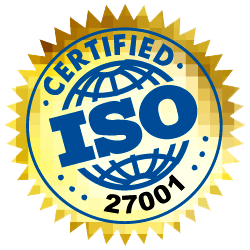
ISO 27001
ISO 27001 is the internationally recognised standard for the Information Security Management System of businesses. It applies to the processes that create and control the Information Security of an organisation. It prescribes systematic control of activities to ensure that the needs and expectations of customers are met.
THE BENEFITS OF IMPLEMENTING ISO 9001:
Implementing a Quality Management System will motivate staff by defining their key roles and responsibilities. Cost savings can be made through improved efficiency and productivity, as product or service deficiencies will be highlighted. From this, improvements can be developed, resulting in less waste, inappropriate or rejected work and fewer complaints. Customers will notice that orders are met consistently, on time and to the correct specification. This can open up the market place to increased opportunities.
WHY SEEK CERTIFICATION TO ISO 9001?
1. It demonstrates the existence of an effective quality management system that satisfies the rigours of an independent, external audit.
2. Mandatory Stage I & Stage II audits are carried out for all our clients.
2. An ISO 9001 certificate enhances company image in the eyes of customers, employees and shareholders alike.
3. It also gives a competitive edge to an organisation's marketing.
HOW DO YOU START TO IMPLEMENT ISO 9001? WHAT IS INVOLVED?
1. Identify the requirements of ISO 9001 and how they apply to the business involved.
2. Establish quality objectives and how they fit in to the operation of the business
3. Produce a documented quality policy indicating how these requirements are satisfied.
4. Communicate them throughout the organisation
5. Evaluate the quality policy, its stated objectives and then prioritise requirements to ensure they are met.
7. dIentify the boundaries of the management system and produce documented procedures as required.
ASSESSMENT TO ISO 9001
Once all the requirements of ISO 9001 have been met, it is time for an external audit. The chosen certification body will review the quality manuals and procedures. This process involves looking at the company's evaluation of quality and ascertains if targets set for the management program are measurable and achievable. This is followed at a later date by a full on-site audit to ensure that working practices observe the procedures and stated objectives and that appropriate records are kept.
After a successful audit, a certificate of registration to ISO 9001 will be issued. There will then be surveillance visits (usually six months or once in a year) to ensure that the system continues to work. This is covered in more detail in NIMBUS Certifications 'Audit Procedure' information sheet.
WHY CHOOSE NIMBUS Certification FOR YOUR AUDIT?
NIMBUS Certifications has an enviable record for customer satisfaction for its iso 9001 consultants services. A friendly approach and a dislike of bureaucracy has led to unprecedented growth through referrals from contented clients. NIMBUS Certifications only employs iso auditors that have empathy with this approach. They are also carefully allocated by their experience in the industry they are auditing. This results in a practical, meaningful audit, carried out in an air of mutual understanding. NIMBUS Certifications firmly believes that its audits should benefit the organisation that requests it, not be an intellectual exercise to 'please' the auditor.
WHAT IS THE COST OF AN AUDIT TO ISO 9001?
Unlike a majority of its competitors, NIMBUS iso certified company produces a guidance price list based on company size. For a copy please get in touch.
For a fixed, written quotation however, we require a few more details. These can be submitted to NIMBUS Certifications via a short questionnaire or alternatively contact NIMBUS for more details. Quotations are provided without any obligation. An information pack about NIMBUS Certifications services can also be requested by call us.
JOINT ISO 27001 , ISO 9000 AND ISO 14001 SYSTEMS
There are several common elements between these three systems, such as management review, document control, corrective action and the requirement for trained personnel. These can be integrated into a single, joint system or a combination of any of the above. Audit of joint systems is available and may be the best method for some companies
